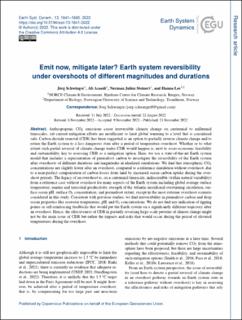| dc.contributor.author | Schwinger, Jörg | |
| dc.contributor.author | Asaadi, Ali | |
| dc.contributor.author | Steinert, Norman | |
| dc.contributor.author | Lee, Hanna | |
| dc.date.accessioned | 2023-01-30T07:40:31Z | |
| dc.date.available | 2023-01-30T07:40:31Z | |
| dc.date.created | 2022-08-23T12:47:57Z | |
| dc.date.issued | 2022 | |
| dc.identifier.citation | Earth System Dynamics. 2022, 13 (4), 1641-1665. | en_US |
| dc.identifier.issn | 2190-4979 | |
| dc.identifier.uri | https://hdl.handle.net/11250/3046971 | |
| dc.description.abstract | Anthropogenic CO2 emissions cause irreversible climate change on centennial to millennial timescales, yet current mitigation efforts are insufficient to limit global warming to a level that is considered safe. Carbon dioxide removal (CDR) has been suggested as an option to partially reverse climate change and to return the Earth system to a less dangerous state after a period of temperature overshoot. Whether or to what extent such partial reversal of climate change under CDR would happen is, next to socio-economic feasibility and sustainability, key to assessing CDR as a mitigation option. Here, we use a state-of-the-art Earth system model that includes a representation of permafrost carbon to investigate the reversibility of the Earth system after overshoots of different durations and magnitudes in idealized simulations. We find that atmospheric CO2 concentrations are slightly lower after an overshoot, compared to a reference simulation without overshoot, due to a near-perfect compensation of carbon losses from land by increased ocean carbon uptake during the overshoot periods. The legacy of an overshoot is, on a centennial timescale, indiscernible (within natural variability) from a reference case without overshoot for many aspects of the Earth system including global average surface temperature, marine and terrestrial productivity, strength of the Atlantic meridional overturning circulation, surface ocean pH, surface O2 concentration, and permafrost extent, except in the most extreme overshoot scenario considered in this study. Consistent with previous studies, we find irreversibility in permafrost carbon and deep ocean properties like seawater temperature, pH, and O2 concentrations. We do not find any indication of tipping points or self-reinforcing feedbacks that would put the Earth system on a significantly different trajectory after an overshoot. Hence, the effectiveness of CDR in partially reversing large-scale patterns of climate change might not be the main issue of CDR but rather the impacts and risks that would occur during the period of elevated temperatures during the overshoot. | en_US |
| dc.description.abstract | Emit now, mitigate later? Earth system reversibility under overshoots of different magnitudes and durations | en_US |
| dc.language.iso | eng | en_US |
| dc.rights | Navngivelse 4.0 Internasjonal | * |
| dc.rights.uri | http://creativecommons.org/licenses/by/4.0/deed.no | * |
| dc.title | Emit now, mitigate later? Earth system reversibility under overshoots of different magnitudes and durations | en_US |
| dc.title.alternative | Emit now, mitigate later? Earth system reversibility under overshoots of different magnitudes and durations | en_US |
| dc.type | Peer reviewed | en_US |
| dc.type | Journal article | en_US |
| dc.rights.holder | © The Author(s) 2022 | en_US |
| dc.description.version | publishedVersion | en_US |
| cristin.ispublished | true | |
| cristin.fulltext | original | |
| cristin.qualitycode | 1 | |
| dc.identifier.doi | 10.5194/esd-13-1641-2022 | |
| dc.identifier.cristin | 2045311 | |
| dc.source.journal | Earth System Dynamics | en_US |
| dc.source.volume | 13 | en_US |
| dc.source.issue | 4 | en_US |
| dc.source.pagenumber | 1641-1665 | en_US |
| dc.relation.project | Norges forskningsråd: 294930 | en_US |
| dc.relation.project | EC/H2020/820989 | en_US |
| dc.relation.project | EC/H2020/869357 | en_US |
| dc.relation.project | Sigma2: NN9708 | en_US |
| dc.relation.project | Sigma2: NS9708 | en_US |

